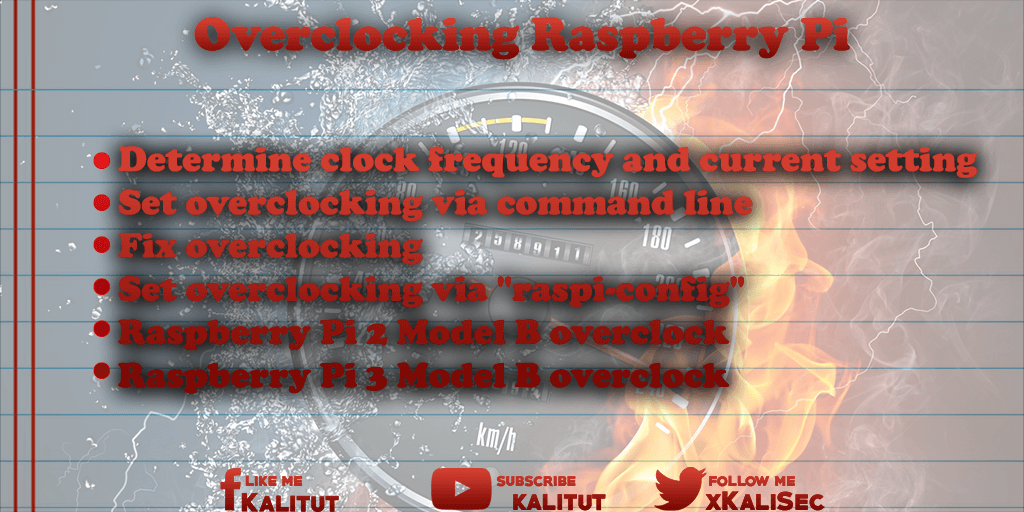How to overclock raspberry pi? Depending on the model, Raspberry Pi has a CPU clock speed of 600 or 700 MHz. If you like, you can overclock Raspberry Pi depending on the model over 1000 MHz.
One should be aware, however, that overclocking shortens the life of Raspberry Pi and can lead to instability of the system.

Note: Typically, a PC needs to be 20 to 30 percent faster to let the user even notice a difference. Only in certain situations, for example, when the line between smooth and jerky video playback is reached, then you notice even slight differences in performance.
Task
- First, determine the frequency with which Raspberry Pi is currently clocked and what is set in the configuration.
- Overclock Raspberry Pi to 800 MHz.
- Reset the original clock frequency.
Solution: Determine clock frequency and current setting
First, we’ll determine the frequency with which Raspberry Pi is currently running.
cat /sys/devices/system/cpu/cpu0/cpufreq/scaling_cur_freq
The indication is in kHz. If Raspberry Pi is not overclocked, then it has a value of “600000” or “700000”.
Then we check which clock frequency is actually set.
cat /sys/devices/system/cpu/cpu0/cpufreq/scaling_max_freq
This information is also in kHz. “700000” is the default setting. If the two values deviate from one another, then overclocking already takes place.
Note: While a Raspberry Pi 1 (A, A +, B, and B + models) runs at 700 MHz by default and is not overclocked, a Raspberry Pi 2 runs at 600 MHz and overclocks to 700 MHz when needed.
Solution: Set overclocking via command line
First we call a configuration file on the boot partition. Here you can make various system settings. Among other things, the clock frequency.
sudo nano /boot/config.txt
Here is a line that needs to be changed. Depending on the model, a different value may also exist here.
arm_freq = 700
Here you enter 800 as the value. That’s equivalent to 800 MHz.
arm_freq = 800
You can also enter more. However, you should be careful about overclocking and first check if the overclocked system is stable.
Then save and close: Ctrl + O, Return, Ctrl + X.
To get the setting, you have to restart Raspberry Pi.
sudo reboot
After the restart, you check whether the settings exist and how high the current clock frequency is.
cat /sys/devices/system/cpu/cpu0/cpufreq/scaling_max_freq
The output should be “800000”.
cat /sys/devices/system/cpu/cpu0/cpufreq/scaling_cur_freq
The output corresponds to the current clock frequency. If the overclocking is done here should be “800000”. That does not have to be that way. If not, then everything is fine.
The reason: Raspberry Pi overclocks dynamically. That is, if the load is high, then Raspberry Pi will dynamically clock up until it reaches the overclocking frequency. If overclocking is not necessary then it will not happen and Raspberry Pi will only run at its 600 or 700 MHz base clock (depending on the model).
- By default, the models A, A +, B and B + have a basic clock of 700 MHz.
- By default, the Model 2 B has a 600MHz basic clock and a dynamic overclocking rate of 900MHz.
Solution: Fix overclocking
Basically, Raspberry Pi works with dynamic overclocking. From when it triggers, you can determine as follows.
cat /sys/devices/system/cpu/cpufreq/ondemand/up_threshold
A value of 50 means that only when the CPU is about 50% full, then the CPU will clock up to the set clock rate. If the demand for computing power goes down, the clock rate also returns to the basic clock.
Changing the clock frequency can cause a short stutter, so setting a fixed clock rate makes sense in some cases.
So if you want Raspberry Pi not to work dynamically, but at a fixed clock rate, then you have to set that manually. For this we open the configuration file with the system settings.
sudo nano /boot/config.txt
There you set the value of “force_turbo”:
force_turbo = 1
After saving, closing and restarting, the clock frequency is set to a permanent value.
Note: If you permanently overclock Raspberry Pi, then you also have to worry about a stable power supply. As a rule, you do not have to worry about cooling.
Solution: Set overclocking via “raspi-config”
“raspi-config” is a tool on the command line. When overclocking has the advantage that it not only changes the clock frequency of the processor, but makes the same meaningful values for other related settings.
Also, those who only use the overclocking feature of “raspi-config”, need not worry about a loss of warranty. The Raspberry Pi is operated within its limits. Overclocking is absolutely harmless. Only those who enter their own values into the “/boot/config.txt”, have to reckon with the Raspberry Pi being set to a non-resettable “warranty-extinguished” bit.
If “raspi-config” is not yet installed:
sudo apt-get install raspi-config
Otherwise you call it like this:
sudo raspi-config

Leave a Reply